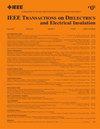Comparison of Initial Voltage Distributions in Layer and Disc Type Power Transformer Windings
IF 2.9
3区 工程技术
Q2 ENGINEERING, ELECTRICAL & ELECTRONIC
IEEE Transactions on Dielectrics and Electrical Insulation
Pub Date : 2024-10-07
DOI:10.1109/TDEI.2024.3473893
引用次数: 0
Abstract
Power transformers are subjected to surge overvoltages which can lead to failure of the windings insulation system. The amplitude of the overvoltages in the windings is dependent on the parameters of the surge voltage (duration, waveform, steepness, etc.) and the design of the windings, thus various winding designs perform differently when surge voltage is applied to their terminals. The transformer winding vulnerability to surge phenomena can be estimated based on the initial voltage distribution. In practice, the initial voltage distribution can be improved by increasing the series or decreasing the ground capacitance of the winding, by design changes, or by application of electrostatic shields. This article presents the analysis of the initial voltage distributions in power transformer windings, comparing layer and disk designs. The analysis was done based on the results of measurements of surge voltage waveforms in real-scale winding models, while a lightning impulse is applied to their terminals. The experimental analysis was extended by simulations of the electrostatic potential distribution in the winding models, and the influence of selected factors (shielding, interleaving turns) on the initial voltage distribution was analyzed and discussed. The article is focused on the comparison of initial voltage distribution in transformer windings of disk and layer designs based on quantitative and qualitative analysis.层式和盘式电力变压器绕组初始电压分布的比较
电力变压器会受到浪涌过电压的影响,这会导致绕组绝缘系统失效。绕组中过电压的幅值取决于浪涌电压的参数(持续时间、波形、陡峭度等)和绕组的设计,因此当浪涌电压施加到其端子时,各种绕组设计的性能不同。根据初始电压分布可以估计变压器绕组对浪涌现象的易损性。在实际应用中,可以通过增加串联或减小绕组的接地电容、改变设计或应用静电屏蔽来改善初始电压分布。本文对电力变压器绕组的初始电压分布进行了分析,并对分层设计和圆盘设计进行了比较。分析是基于实际绕组模型中雷电冲击作用下的浪涌电压波形的测量结果。通过对绕组模型中静电电位分布的模拟,扩展了实验分析,并分析和讨论了所选因素(屏蔽、交错匝数)对初始电压分布的影响。本文在定量分析和定性分析的基础上,重点比较了盘形设计和层形设计的变压器绕组初始电压分布。
本文章由计算机程序翻译,如有差异,请以英文原文为准。
求助全文
约1分钟内获得全文
求助全文
来源期刊
CiteScore
6.00
自引率
22.60%
发文量
309
审稿时长
5.2 months
期刊介绍:
Topics that are concerned with dielectric phenomena and measurements, with development and characterization of gaseous, vacuum, liquid and solid electrical insulating materials and systems; and with utilization of these materials in circuits and systems under condition of use.

 求助内容:
求助内容: 应助结果提醒方式:
应助结果提醒方式:


